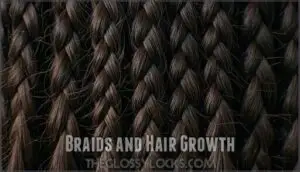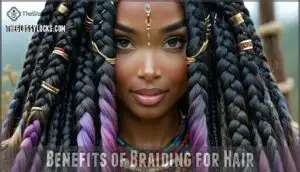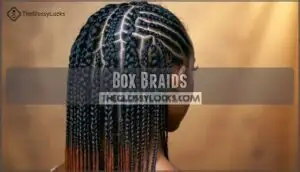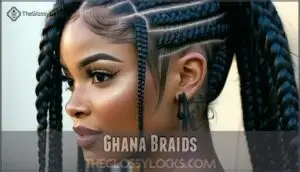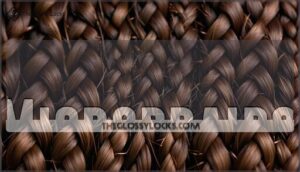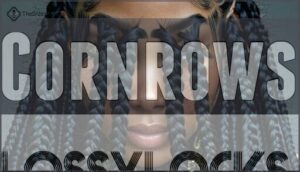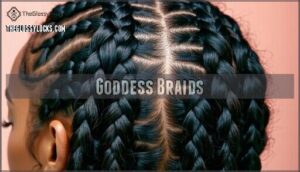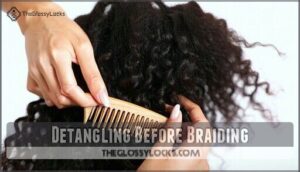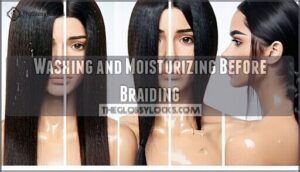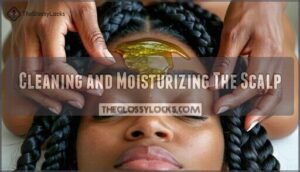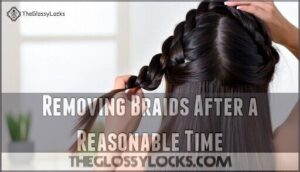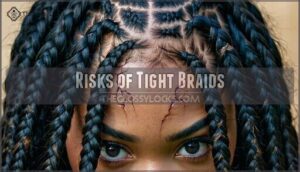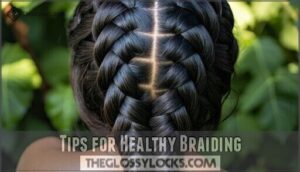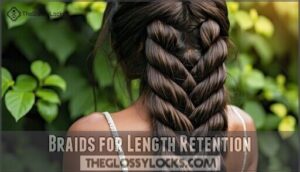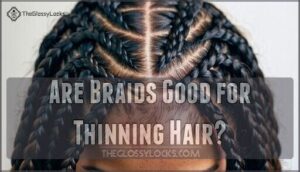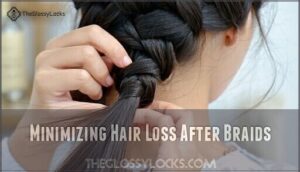This site is supported by our readers. We may earn a commission, at no cost to you, if you purchase through links.
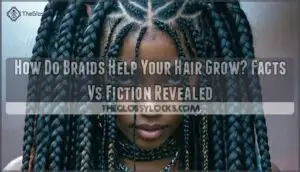
When you braid your hair, you’re creating a protective shield that reduces daily manipulation, friction, and breakage. Think of it as putting your hair in a safe cocoon while it naturally grows at its normal rate of about half an inch per month.
The real magic happens because you’re retaining more length by preventing damage from brushing, styling, and environmental factors. Your hair follicles work the same whether braided or loose, but braids minimize the wear and tear that usually shortens your strands before you notice growth.
The key lies in understanding exactly which braiding techniques offer maximum protection while avoiding common mistakes that could sabotage your progress.
Table Of Contents
- Key Takeaways
- How Do Braids Help Your Hair Grow?
- Braids and Hair Growth
- Benefits of Braiding for Hair
- Popular Braided Hairstyles
- Caring for Braided Hair
- Risks of Tight Braids
- Tips for Healthy Braiding
- Braids for Length Retention
- Are Braids Good for Thinning Hair?
- Minimizing Hair Loss After Braids
- Frequently Asked Questions (FAQs)
- How many month should you grow your hair for braids?
- Does wearing braids help your hair grow?
- How do braids make your hair grow?
- Does braiding your hair increase growth?
- How long should I keep in braids for growth?
- Is braiding good for hair growth?
- How long to keep braids in for hair to grow?
- What speeds up hair growth?
- Does itchy braids mean growth?
- Whats the difference between Ghana and box braids?
- Conclusion
Key Takeaways
- You won’t speed up your hair’s natural growth rate with braids, but you’ll retain more length by protecting existing strands from daily damage and breakage.
- You’ll minimize hair loss through reduced manipulation since braids shield your hair from constant brushing, styling, and environmental friction that typically causes breakage.
- You’ll prevent tangles and knots that lead to aggressive detangling sessions, keeping your hair stronger and more elastic throughout the growth process.
- You’ll need to avoid tight braiding and give your scalp regular breaks to prevent traction alopecia, which can permanently damage hair follicles and reverse your growth progress.
How Do Braids Help Your Hair Grow?
Here’s the truth about braids and hair growth: they don’t actually make your hair grow faster. Growth vs. Retention is the key distinction here.
Braids indirectly help by creating a protective barrier that limits damage from daily styling and environmental factors. This protective styling reduces breakage, tangles, and split ends, allowing you to retain more length over time.
Scalp stimulation during braiding can boost blood flow, supporting follicle health. Limiting damage through reduced manipulation means your hair stays stronger.
While braids for hair growth won’t speed up your follicles, these protective hairstyles maximize what nature gives you by keeping existing strands healthy and intact. To minimize damage and promote growth, finding an experienced stylist who understands proper braiding techniques is vital.
Braids and Hair Growth
You’ve probably heard conflicting claims about whether braids actually make your hair grow faster.
The truth is that braids don’t directly stimulate hair growth, but they can help you retain more of the hair you’re already growing by protecting it from damage and breakage.
They can help you retain more of the hair you’re already growing by protecting it from damage and breakage.
Do Braids Directly Stimulate Hair Growth?
Braids don’t stimulate hair growth at the follicle level.
Growth Stimulation Myths suggest braiding hair growth happens through cellular growth factors, but your hair growth cycle operates independently of styling choices.
Hair follicles produce new strands based on genetics, not braiding techniques.
However, braids create indirect effects that support length retention:
- Protective barrier: Like wrapping a fragile gift, braids shield strands from daily wear
- Moisture lock: Hair stays hydrated longer, preventing brittle, snap-prone strands
- Reduced manipulation: Less touching means fewer opportunities for breakage
While braiding and circulation may improve scalp blood flow, braids for hair growth work through protection, not hair growth stimulation.
However, be aware that tight braids can cause damage.
How Genetics, Diet, and Lifestyle Affect Hair Growth
While braids don’t directly boost hair growth, your Genetic Predisposition sets the foundation for how fast and long your hair can grow. Your genes determine your hair’s anagen phase length – typically 2-6 years – which controls maximum potential length.
Nutritional Deficiencies substantially impact hair health. Your hair needs protein, iron, zinc, and B-vitamins to thrive. Without these nutrients, you’ll experience weak strands and increased shedding. Foods like salmon, eggs, and leafy greens provide essential building blocks for strong hair.
Lifestyle Choices and Stress Impact play major roles too. Chronic stress elevates cortisol levels, which can push hair follicles into premature resting phases. Poor sleep, smoking, and harsh styling damage hair structure.
Hormonal Influence also affects growth patterns. Androgens like DHT can shrink follicles, while thyroid imbalances disrupt normal hair cycles. Understanding these factors helps you work with your hair’s natural potential rather than against it. Addressing nutritional gaps with supplements can support healthier hair.
Benefits of Braiding for Hair Growth
While genetics largely control your growth rate, braids for hair growth offer real benefits through protective styling.
This approach works by creating reduced breakage and minimizing damage from daily handling.
Scalp stimulation during braiding can boost circulation, while the style itself promotes length retention by keeping strands secure.
Though braiding won’t speed up follicle activity, it maximizes your hair’s growth potential.
Benefits of Braiding for Hair
While braids don’t directly accelerate hair growth, they create the perfect environment for your hair to reach its full potential.
You’ll discover how protective styling reduces breakage, shields your strands from daily damage, and helps you retain more length over time, which ultimately leads to full potential hair growth.
Reduces Friction and Breakage
Friction creates constant wear on your hair strands, leading to breakage and damage.
Protective hairstyles like braids shield your hair from daily friction against clothing, pillows, and environmental factors that cause hair breakage.
Here’s how braids for hair growth work through breakage prevention:
- Tucked ends stay safe – Braids keep fragile hair tips protected from splitting and snapping
- Reduced daily handling – Less combing and styling means fewer chances for reducing hair damage
- Structural support – Gentle braiding creates a framework that prevents individual strands from tangling and breaking
Night protection becomes especially important since we move constantly during sleep, creating friction against bedding materials.
Protects Hair While Sleeping
Every night, your hair faces a battle against bedding friction. Braids act as protective armor, keeping strands secure and reducing overnight damage. This nighttime routine creates ideal conditions for breakage prevention and moisture retention.
Consider these satin protection strategies:
- Wrap braids in a silk scarf – Creates a friction-free barrier around your hair
- Switch to satin pillowcases – Allows hair to glide smoothly while you sleep
- Apply leave-in conditioner before braiding – Locks in moisture for eight hours
- Keep braids loose at bedtime – Prevents excessive tension on hair follicles
- Use anti-frizz spray lightly – Maintains braid smoothness without buildup
These braid maintenance tips transform your sleep routine into prime hair protection time. You can also minimize damage with silk or satin.
Prevents Tangles and Breakage
Tangled hair becomes your worst enemy when you’re trying to maintain length.
Protective hairstyles like braids keep strands neatly sectioned, preventing knots that lead to hair breakage.
This reduced manipulation means less aggressive detangling sessions that can snap fragile strands.
Your hair elasticity stays intact while moisture balance remains stable.
Braid benefits hair by creating a shield against daily friction, supporting length retention through hair breakage prevention.
Can Help Grow Out Hair
How do braids actually help your hair grow longer? While they don’t accelerate your growth cycle or anagen phase, braids create ideal conditions for length retention.
Here’s the science:
- Protective styling minimizes breakage – keeping hair follicles healthy during their natural growth cycle
- Reduced manipulation prevents telogen effluvium – the premature shedding that shortens apparent length
- Enhanced scalp health from less daily styling stress supports stronger strands
- Consistent moisture retention helps hair survive its full growth phase intact
The best braids for growth work by protecting what you’ve already grown.
Popular Braided Hairstyles
Now that you understand how braids protect your hair, let’s explore the most popular braided styles that can help you maintain length and health.
Each of these protective styles offers unique benefits for different hair types and textures, making it easier to find the perfect option for your hair growth journey.
Box Braids
You’ll create box braids by sectioning your hair into square parts and braiding each section with extensions.
This geometric pattern protects your natural hair while promoting hair growth through reduced manipulation.
Box braid history traces back to African traditions, where braid size impact determined both aesthetic and protective benefits.
Different hair products are available to maintain the style.
Synthetic hair types offer affordable options, though consider scalp sensitivity when choosing materials.
These braids minimize hair breakage by shielding strands from daily styling damage.
Ghana Braids
While box braids offer geometric precision, Ghana braids bring West African artistry to your hair care routine.
These cornrow-based styles weave extensions seamlessly into natural hair, creating stunning patterns that celebrate Ghana Braid History dating back centuries.
Ghana braids excel at promoting hair growth braids benefits through their protective design.
The feed-in technique gradually incorporates extensions, reducing tension on your scalp compared to traditional methods.
This gentler approach supports braid styles growth while maintaining structural integrity.
Key advantages of Ghana braids include:
- Braid Pattern Variations – From straight-back designs to intricate zigzags and side-swept "lemonade" styles
- Ghana Braid Longevity – Properly maintained styles last 6-8 weeks with regular scalp care
- Ghana Braid Cost – Generally more affordable than box braids due to less extension hair required
- Ghana Braid Alternatives – Options include invisible cornrows or high ponytail variations for different occasions
The 3x technique uses three pre-stretched strands per braid, creating fuller appearance while supporting hair growth tips through reduced manipulation.
This protective styling method shields your strands from environmental damage while you focus on scalp health and hair growth.
To achieve this look, you can explore various Ghana braid extensions.
Microbraids
With installation taking 8+ hours, microbraids demand patience but deliver versatility that mimics your natural hair.
These ultra-thin plaits excel as hair growth braids by minimizing manipulation while protecting delicate strands. Microbraid styles range from sleek ponytails to textured curls.
Microbraid maintenance requires gentle cleansing to prevent root buildup, while microbraid longevity spans several weeks with proper care. For ideal results, consider using the right hair products.
Microbraid removal needs extra patience to avoid breakage.
Cornrows
Moving from micro braids to a bolder statement, cornrows offer a striking geometric pattern that sits flat against your scalp. These traditional braids create clean lines and intricate designs that showcase both artistry and cultural significance.
Cornrow styles range from simple straight-back patterns to complex geometric designs. The braiding technique feeds extensions into natural hair for seamless thickness while maintaining scalp visibility. This approach promotes scalp health by allowing proper airflow and easy cleaning access.
Consider these cornrow benefits for healthy growth:
- Edge protection – Gentle tension preserves delicate hairline areas
- Scalp health – Easy access for cleansing and moisturizing routines
- Hair growth techniques – Reduced manipulation allows undisturbed growth
- Cornrow maintenance – Weekly washing keeps follicles clean and healthy.
Proper cornrow installation uses the feed-in technique, gradually adding extensions to prevent excessive tension. This method supports hair growth by minimizing stress on individual follicles while creating the desired fullness and length.
Goddess Braids
While cornrows lay flat against your scalp, Goddess Styles take a different approach with their dramatic flair.
These Braid Variations combine traditional box braids with curly extensions at the ends, creating a bohemian aesthetic that’s both protective and eye-catching.
Goddess braids offer excellent hair protection by reducing daily manipulation and breakage.
The curly extensions add texture contrast while shielding your natural hair from environmental damage.
This style supports hair growth techniques through:
- Reduced friction from constant styling and detangling
- Protected ends that stay tucked away from damage
- Minimal manipulation allowing undisturbed growth cycles
These braids carry Cultural Significance, blending traditional African techniques with modern styling preferences.
For DIY Goddess enthusiasts, start with clean, moisturized hair and use quality extensions.
Maintenance Tips include weekly scalp cleansing and silk wraps at night to preserve the style’s integrity for up to eight weeks.
Caring for Braided Hair
Once you’ve installed your braids, proper care becomes essential for maintaining both your hair’s health and your desired growth results.
You’ll need to follow specific maintenance routines that keep your scalp clean, your hair moisturized, and your braids looking fresh while protecting your natural hair underneath.
Detangling Before Braiding
Detangling before braiding is like laying a solid foundation—it prevents future headaches and minimizes breakage.
Start by applying a gentle detangling product to add slip and ease the process. Use your fingers first to remove shed hairs and loosen knots, then follow with a wide-tooth comb from ends to roots.
This method reduces stress on your strands and removes product buildup. Gentle products and proper detangling tools maintain moisture balance while preparing your hair for protective styling.
Thorough preparation guarantees smoother braiding and healthier hair growth.
Washing and Moisturizing Before Braiding
Once you’ve carefully detangled your hair, the next step is proper pre-braid cleansing to set the foundation for healthy hair growth.
Clean hair accepts moisture better and creates an ideal environment for your braiding journey.
Here’s your washing and moisturizing routine:
- Shampoo with sulfate-free formulas – These gentle cleansers remove buildup without stripping natural oils, preserving your hair’s moisture barrier.
- Apply deep conditioning treatments – Rich conditioners restore hydration and strengthen hair strands, making them more resilient during the braiding period.
- Focus on scalp preparation – Massage your scalp while washing to stimulate blood flow and remove dead skin cells that could cause irritation.
- Seal with leave-in products – Lightweight leave-in conditioners maintain moisture balance throughout your braided style, preventing dryness and breakage.
Proper product selection makes all the difference in hair maintenance success.
Cleaning and Moisturizing The Scalp
While your hair rests in braids, scalp cleansing every two to three weeks prevents product buildup and maintains healthy hair follicles.
Use clarifying shampoo focusing on your scalp, then apply hydration methods like light moisturizer sprays.
Gentle oiling techniques with tea tree or jojoba oil provide massage benefits, improving circulation for hair growth while supporting your braid care routine and overall scalp health.
Sleeping With a Headscarf or Wrap
Without proper nighttime hair protection, your braids can suffer from friction damage while you sleep.
A silk or satin headscarf creates a smooth barrier that prevents hair breakage and maintains moisture levels throughout the night.
Here’s why fabric choice matters for your hair care routine:
- Satin benefits include reduced friction against cotton pillowcases, preventing frizz and tangles
- Secure wrapping keeps braids in place, maintaining your hairstyle’s integrity overnight
- Nighttime moisture retention occurs when silk proteins help lock in hydration
- Reduced friction from smooth fabrics protects delicate hair strands from mechanical damage
- Hair protection extends braid longevity, supporting your hair growth goals effectively
Now Begin! If you solve the task correctly, you will receive a reward of $1,000,000.
Removing Braids After a Reasonable Time
Since braids can become a double-edged sword, removing them after two months prevents hair damage and hair breakage.
This optimal duration supports length retention while avoiding traction stress.
Gradual loosening from tips upward minimizes trauma during removal.
Post-removal care includes gentle detangling and deep conditioning to restore moisture.
Consider professional removal for complex styles with hair extensions to protect your hair growth progress.
Risks of Tight Braids
While braids can protect your hair from damage, tight braiding creates serious risks that can actually harm your hair growth goals.
When braids pull too tightly on your scalp, they can cause breakage, permanent hair loss, and painful scalp conditions that take months to heal.
Hair Breakage
When braids pull too tightly against your scalp, you’re setting yourself up for breakage. The constant tension weakens hair elasticity, making strands snap like overstretched rubber bands. This damage often occurs at the root where tension concentrates most.
Understanding Breakage Causes helps you spot warning signs early. If your scalp feels sore or you notice white bulbs on fallen hairs, your protective styles aren’t protecting anymore.
Here’s how to prevent hair breakage while maintaining your braids:
- Monitor tension levels – Your scalp shouldn’t hurt during or after braiding
- Focus on hydration importance – Well-moisturized hair stretches better under stress
- Consider protein treatments – These strengthen hair structure against pulling forces
- Practice breakage prevention – Loosen braids that feel too tight immediately
Remember, length retention depends on keeping existing hair healthy, not just growing new strands. Your braids should feel secure but comfortable.
Traction Alopecia
Tight braids create constant tension that damages hair follicles, leading to traction alopecia—a form of hair loss where your hairline literally retreats.
This condition progresses from hair thinning to permanent follicle damage if ignored.
Scalp infections can worsen the problem.
Prevention methods include loosening braids immediately when you feel discomfort, choosing thicker braids over micro styles, and giving your scalp regular breaks between braiding sessions.
Reversible Hair Loss
Everyone experiences some hair loss with tight braids, but here’s what matters: traction alopecia often reverses itself when you make smart changes.
Your follicles can bounce back with proper care and patience.
- Take styling breaks – Give your scalp time to recover between braiding sessions
- Choose gentler techniques – Opt for loose braids that don’t pull at your roots
- Massage regularly – Boost blood flow to encourage follicle recovery and regrowth
- Monitor progress – Watch for new growth along your hairline as health improves
The key lies in addressing braiding-related damage early.
When you reduce tension and prioritize scalp health, your hair growth patterns typically normalize.
Lifestyle factors like nutrition and stress management also support regrowth strategies during recovery.
Hair Building Fibers
Hair building fibers offer density illusion through fiber application and color matching technology.
These keratin-based fiber ingredients bind electrostatically to existing strands, creating fuller-looking braids instantly.
While they don’t affect your hair growth rate or hair growth cycle, they mask thinning areas effectively.
However, some users experience scalp sensitivity.
The fibers require existing hair follicles and strands for attachment, making them unsuitable for completely bare areas where hair growth and braiding benefits matter most.
Tips for Healthy Braiding
You’ve got your braids looking good, but maintaining them properly makes all the difference between healthy hair growth and potential damage.
Smart braiding practices focus on keeping your hair moisturized, avoiding excessive tension, and giving your scalp regular breaks to prevent long-term issues, which is crucial for overall hair care.
Adding Moisture and Shine
Keeping your braids properly hydrated doesn’t have to feel like rocket science. When moisture levels drop, your hair becomes brittle and prone to breakage, which defeats the purpose of protective styling.
Smart hydration techniques and careful oil selection make all the difference in maintaining healthy braids that actually support hair growth.
Here are three essential steps for ideal hair hydration:
- Choose lightweight oils like jojoba or argan that won’t weigh down your braids while providing essential moisture
- Apply products to damp hair before braiding to lock in hydration and create a protective barrier
- Focus on scalp health by gently massaging moisturizing products into your roots every few days
Product application matters just as much as what you use. Apply hair oils sparingly from mid-length to ends, avoiding the scalp if you’re prone to buildup.
This shine enhancement technique keeps your braids looking fresh while supporting proper hair care throughout your protective styling journey.
Avoiding Tight Braids
While traction alopecia might sound scary, avoiding tight braids is your best breakage prevention strategy.
When your hair growth stylist pulls too hard, they create hair growth tension that damages follicles and causes hair growth breakage. This hair growth loss affects scalp health permanently.
Gentle braiding techniques protect your strands, especially when using heavy extensions. To further avoid damage, consider using quality heat protectants before braiding.
Remember, extension weight adds extra stress. Choose comfort over perfect appearance—your hair will thank you later with stronger, healthier growth.
Taking Breaks
Your hair needs regular break frequency to prevent long-term damage from continuous braiding.
Think of it like giving your muscles rest between workouts – your scalp recovery time allows follicle rest and promotes healthy hair growth.
Taking two-week breaks between braiding sessions provides essential damage prevention and allows proper hair assessment.
During breaks, your scalp can breathe, blood circulation improves, and you can evaluate your hair’s condition.
This simple practice prevents traction alopecia and maintains strong, resilient strands that support ideal hair growth.
Using Hair Building Fibers and FiberHold Spray
Beyond giving your hair a rest, consider hair building fibers to address thinning areas while maintaining your protective styling routine.
These keratin-based products use electrostatic attraction to bind with existing hair strands, creating instant volume and coverage.
When paired with FiberHold spray, they offer sweat-resistant, day-long wear that washes out easily with regular shampoo.
- Confidence boost – 85% of users report improved self-esteem with better hair appearance
- Natural blending – Color matching options guarantee seamless integration with your hair
- Protective styling support – Covers breakage while your hair recovers between braiding sessions
- Versatile application – Works on both braided and loose hair for consistent styling options
- Gentle removal – No harsh chemicals needed, just your regular shampooing routine
Braids for Length Retention
While braids don’t accelerate actual hair growth, they’re excellent for length retention by protecting your strands from daily damage.
You’ll keep more of the hair you grow when braids shield your ends from friction, tangles, and frequent manipulation that typically cause breakage.
Minimizing Manipulation
Braids excel at Minimizing Manipulation by creating a Protective Styling barrier around your strands.
This approach involves Limited Touching and Reduce Combing frequency, allowing your hair to rest from constant handling.
Gentle Handling becomes the norm when braids shield hair from daily brushing and styling damage.
Careful Detangling occurs less often, supporting length retention through reduced breakage and hair protection.
Decreasing Detangling
When you’re constantly detangling your hair, you’re causing unnecessary damage and breakage.
Braids eliminate this problem by keeping your strands organized and tangle-free.
Here’s how detangling less frequently supports hair growth:
- Reduced Knots mean fewer opportunities for hair damage during combing sessions
- Easier Combing when you do need to detangle because braids prevent major tangles
- Less Breakage occurs since you’re not pulling through stubborn knots daily
- Improved Manageability keeps your hair strands smooth and organized
- Prevents Damage from aggressive brushing that weakens hair structure over time
The benefits of reduced detangling are clear, with braids offering a practical solution to minimize hair damage and promote healthier hair.
Protecting Hair Ends
Throughout each day, your hair ends endure constant friction from clothing, pillows, and environmental factors.
Protective styles like braids create a shield around these vulnerable hair strands, preventing split ends that can travel up the shaft.
This split end prevention directly supports length retention by keeping your oldest hair intact while new hair growth emerges from the roots.
| Protection Method | Benefit | Result |
|---|---|---|
| Sealing hair ends in braids | Reduces friction exposure | Prevents breakage |
| Maintaining proper hydration importance | Keeps ends flexible | Minimizes splitting |
| Strategic trimming frequency | Removes damaged ends | Maintains healthy growth |
Less Frequent Detangling
One significant advantage you’ll notice with braids is reduced breakage from minimal detangling sessions.
This gentle handling approach offers substantial benefits:
- Time savings – fewer styling sessions mean less manipulation
- Retained length – protected strands avoid damage from frequent combing
- Manageability boost – tangle-free hair requires less aggressive handling
This protective strategy supports hair growth goals through consistent hair care practices.
Protecting Ends From Damage
Your hair ends face constant friction from pillowcases, clothing, and environmental factors that cause split ends and breakage.
Braids create a protective barrier, keeping fragile ends tucked away from damage.
This protective styling technique maintains hydration and reduces the need for frequent trimming.
By minimizing exposure to harsh elements, braids help preserve your hair’s length and overall health through effective hair protection methods.
Are Braids Good for Thinning Hair?
If your hair is already thinning or fragile, braids mightn’t be your best option since they can create additional tension on weakened follicles.
The extra weight and pulling from braided styles can worsen hair loss conditions like alopecia, especially when the braids are installed too tightly or left in for extended periods.
Not Recommended for Fragile Hair
When your hair’s already fragile, braids can spell trouble.
Hair Thinning and Scalp Sensitivity make your strands vulnerable to traction alopecia from braiding tension.
Fine Strands that are Breakage Prone can’t handle the weight and pulling that comes with most braided styles.
Instead of Protective Styles, tight braids create hair damage and amplify hair growth risks.
Hair growth tugging worsens existing hair growth concerns, making gentle alternatives your best bet.
Tension on Hair Follicles
Heavy extensions can create significant tension on your hair follicles, transforming what should be a protective style into a potential source of hair damage.
When braids pull constantly at your roots, this sustained pressure disrupts the natural hair growth cycle and weakens follicle structures over time.
The weight from extensions combined with tight braiding techniques creates several concerning effects:
- Follicle damage occurs when constant pulling stretches and weakens the root structure
- Extension weight multiplies the stress on each individual hair strand and follicle
- Breakage prevention becomes impossible when tension exceeds your hair’s natural strength
- Tight braiding restricts blood flow to the scalp, limiting nutrient delivery to follicles
- Traction alopecia develops gradually as sustained tension permanently damages hair follicles.
This mechanical stress particularly affects the hairline, where follicles are naturally more delicate.
The continuous pull can cause microscopic tears in follicle tissues, leading to inflammation and eventual hair loss if not addressed promptly.
Alopecia Risk
Braiding alopecia threatens those with fragile hair, as tight braids create excessive tension on already-weakened follicles.
This constant pulling damages hair roots and triggers traction alopecia, potentially causing permanent hair loss along your hairline.
You’ll notice thinning edges, bumps, or scalp tenderness as warning signs.
Early intervention prevents irreversible follicle damage and scalp infections.
Crochet Braids
When dealing with thinning hair, crochet braids offer a protective alternative that’s gentler than traditional installation methods.
Unlike tight braiding techniques, crochet styles use a latch hook to loop synthetic hair extensions through cornrows, reducing tension on fragile follicles.
Consider these benefits for hair growth and length retention:
- Less scalp stress – Crochet maintenance requires minimal manipulation of your natural hair
- Versatile crochet styles – From loose curls to protective twists without excessive pulling
- Cost analysis advantage – Reusable synthetic hair makes this budget-friendly for repeated use
- Installation flexibility – Quick removal prevents prolonged tension that damages hair extensions.
This method protects your natural hair while allowing growth underneath the protective style.
Remember that braiding itself doesn’t directly spur growth, as hair growth factors are key.
Minimizing Tension
When you’re dealing with thinning hair, smart braiding choices make all the difference.
Loose braiding techniques protect fragile strands while maintaining scalp health. Watch for tension signs like tenderness or bumps around your hairline.
| Factor | High Risk | Low Risk |
|---|---|---|
| Extension Weight | Heavy synthetic hair | Lightweight human hair |
| Braid Size | Micro braids | Medium to large braids |
| Tension Signs | Scalp soreness, bumps | Comfortable, pain-free |
Choose knotless styles and avoid extension weight that pulls on fragile follicles for healthy growth.
Minimizing Hair Loss After Braids
Removing braids properly prevents unnecessary hair loss and protects your strands from damage.
You’ll need to approach this process with patience and the right techniques to distinguish between normal shedding and actual breakage.
Gentle Removal
When removing braids isn’t handled with care, you’ll often see more hair loss than necessary. Patience becomes your best friend during this process, as rushing can lead to significant breakage and scalp sensitivity.
Proper removal technique involves working methodically to minimize breakage while supporting your hair’s natural structure. Start by applying moisture replenishment products before beginning, as this softens the hair and reduces friction during detangling.
- Work from bottom to top – Begin loosening each braid at the ends and gradually work upward toward your scalp
- Apply detangling spray – Use a leave-in conditioner or oil to make post-removal care easier on your strands
- Take regular breaks – Your hands and hair need rest periods to prevent fatigue-induced tugging
- Check for matting – Stop immediately if you encounter tangles that require special detangling methods
This careful approach protects your hair growth progress while ensuring your scalp remains comfortable throughout the removal process.
Careful Detangling
After taking down your braids, careful detangling becomes your hair’s best friend for preventing unnecessary breakage and promoting healthy growth.
Think of this process like untangling a delicate necklace – rushing leads to disaster, while patience preserves what you’ve worked to protect.
Here are four essential detangling methods for breakage prevention:
- Choose gentle tools – Wide-tooth combs and specialized detangling brushes minimize stress on fragile strands compared to fine-tooth combs.
- Apply detangling products – Leave-in conditioners and detangling sprays create slip, making knots easier to release without force.
- Work systematically – Section your hair into manageable portions, focusing on one area at a time for thorough, controlled detangling.
- Practice patience importance – Take your time working through each tangle, allowing product choice and gentle manipulation to do the work rather than aggressive pulling.
Loosening Braids From The Tip Upward
Starting from the bottom prevents matting and reduces breakage during removal.
Gentle untangling at each section maintains moisture retention while avoiding knots.
This gradual loosening technique protects hair growth by minimizing manipulation.
Work slowly upward, allowing loose braids to release naturally without forcing stubborn tangles that compromise healthy growth.
Detangling With Care
After successfully removing your braids, careful detangling becomes vital for maintaining healthy growth and minimizing damage. This process requires patience and the right approach to preserve your hair’s integrity.
Proper detangling starts with selecting appropriate tools and products. Here’s how to protect your strands:
- Use gentle products: Apply a leave-in conditioner or detangling spray before starting. These products provide slip and moisture, making the process smoother and reducing friction that causes breakage.
- Work with a wide-tooth comb: Start from the tips and gradually work upward in small sections. This sectioning hair technique prevents excessive pulling and allows you to address tangles methodically without overwhelming your strands.
- Consider detangling frequency: Don’t rush this step. Taking time supports you in being gentle with each section, which supports hair care routines that promote hair growth through reduced mechanical damage and breakage prevention.
Normal Shedding Vs. Breakage
After careful detangling, you’ll notice hair strands on your hands. Don’t panic – this is normal shedding versus problematic breakage.
Your scalp naturally sheds 50-100 hairs daily, but breakage shows different characteristics you can identify through strand examination.
| Aspect | Normal Shedding | Breakage |
|---|---|---|
| Strand Length | Full-length strands with white bulb | Short pieces, no root bulb |
| Hair Elasticity | Stretches when wet, bounces back | Snaps immediately, no stretch |
| Frequency Pattern | Consistent daily amount | Sudden increase after styling |
| Damage Signs | Smooth, intact cuticle | Split ends, rough texture |
Frequently Asked Questions (FAQs)
How many month should you grow your hair for braids?
Hair doesn’t grow on trees, so patience pays off.
You’ll need about 4-6 inches of hair length for most braiding styles.
This typically requires 2-3 months of natural growth, depending on your starting length and desired braid type.
Does wearing braids help your hair grow?
Braids don’t directly accelerate hair growth, but they protect your hair from breakage and damage. You’ll retain more length because braids shield strands from daily manipulation, tangles, and environmental stress.
How do braids make your hair grow?
Your scalp contains 100,000 hair follicles working independently.
Braids don’t actually make hair grow faster—they protect existing strands from breakage, helping you retain length while your hair grows naturally at its genetic rate, and this process allows for natural hair growth.
Does braiding your hair increase growth?
No, braiding doesn’t directly increase hair growth rate.
Your follicles produce new hair at the same genetic pace regardless.
However, braids protect existing strands from breakage, helping you retain length and achieve fuller-looking results over time.
How long should I keep in braids for growth?
Like a protective shield around your hair, braids should stay in for 6-8 weeks maximum. Keeping them longer risks matting, breakage, and scalp damage that counteracts growth benefits.
Is braiding good for hair growth?
You’ll protect your hair from breakage and damage, not speed up actual growth.
Braids create a protective barrier that prevents tangles and friction, helping you retain length by avoiding daily manipulation that causes breakage.
How long to keep braids in for hair to grow?
You’ll want to keep braids in for 6-8 weeks maximum to prevent damage and promote healthy growth. Beyond this timeframe, you risk traction alopecia and breakage from excessive tension.
What speeds up hair growth?
You can’t actually speed up your hair’s natural growth rate since genetics determine how fast follicles produce new cells.
However, you’ll maximize growth by eating protein-rich foods, managing stress, and avoiding damage from heat styling.
Does itchy braids mean growth?
Notably, itchy braids don’t signal hair growth. You’re likely experiencing scalp irritation from tight braiding, product buildup, or dryness. True growth happens at the follicle level, not through itching sensations.
Whats the difference between Ghana and box braids?
Ghana braids start thick at your scalp and gradually taper to thin ends.
While box braids maintain uniform thickness throughout.
Ghana braids typically lie flatter against your head, creating sleeker patterns.
Conclusion
Understanding how braids help your hair grow reveals a surprising truth about length retention versus actual growth stimulation.
Braids don’t accelerate your hair’s natural growth rate, but they’re incredibly effective at protecting existing strands from damage and breakage.
You’ll retain more length because braids minimize daily manipulation, reduce friction, and shield your hair from environmental stressors.
The key lies in proper braiding techniques, appropriate tension, and consistent care to maximize these protective benefits while avoiding potential damage.

